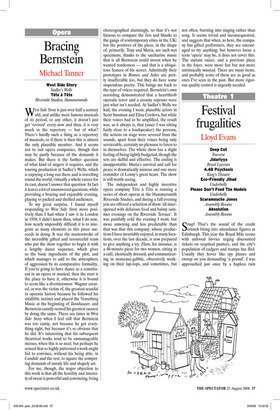Bracing Bernstein
Michael Tanner
West Side Story Sadler’s Wells Tête à Tête Riverside Studios, Hammersmith
West Side Story is just over half a century old, and unlike most famous musicals of its period, or any other, it doesn’t just get ‘revived’ every now and then, it is very much in the repertory — but of what? There’s hardly such a thing as a repertory of musicals, or if there is then this is almost the only plausible member. And it seems not to suit opera companies, though that may be partly because of the demands it makes. But there is the further question of what kind of singers it requires, and the touring production at Sadler’s Wells, which is enjoying a long run there and is travelling round the world, virtually a whole career for its cast, doesn’t answer that question. In fact it leaves a lot of unanswered questions, while providing a bracing and enjoyable evening, playing to packed and thrilled audiences.
To my great surprise, I found myself responding to West Side Story more positively than I had when I saw it in London in 1958. I didn’t know then, what I do now, how nearly impossibly difficult it is to integrate as many elements as this piece succeeds in doing. It was the masterstroke of the incredibly gifted and resourceful team who put the show together to begin it with a lengthy dance sequence, which gives us the basic ingredients of the plot, and which manages to add to the atmosphere of aggression by its comparative formality. If you’re going to have dance as a constituent in an opera or musical, then the start is the place to have it, otherwise it is bound to seem like a divertissement. Wagner created, or was the victim of, the greatest scandal in operatic history because he followed his infallible instinct and placed the Venusberg Music at the beginning of Tannhauser, and Bernstein cannily scored his greatest success by doing the same. There are times in West Side Story when I feel still that Bernstein was too canny, not because he got everything right, but because it’s so obvious that he did. It’s interesting that his subsequent theatrical works tend to be unmanageable messes, when this is so neat; but perhaps he sensed that so highly patterned a work might fail to convince, without his being able, in Candide and the rest, to square the competing demands of unruly life and shapely art.
For me, though, the major objection to this work is that all the hostility and intensity of sweat is powerful and convincing, being choreographed alarmingly, so that it’s not fatuous to compare the Jets and Sharks to the gangs of contemporary cities in the UK; but the positives of the piece, in the shape of, primarily, Tony and Maria, are such wet specimens, thanks to the saccharine music that is all Bernstein could invent when he wanted tenderness — and that is a ubiquitous feature of his scores. Admittedly their prototypes in Romeo and Juliet are pretty insufferable too, but they do have some stupendous poetry. This brings me back to the type of voices required. Bernstein’s own recording demonstrated that a heartthrob operatic tenor and a creamy soprano were just what isn’t needed. At Sadler’s Wells we had, the evening I went, plausible actors in Scott Sussman and Elisa Cordova, but while their voices had to be amplified, the result was, as it always is, that (since I was sitting fairly close to a loudspeaker) the persons, the actions on stage were severed from the sounds, apart from their voices being only serviceable, certainly no pleasure to listen to in themselves. The whole show has a slight feeling of being tightly budgeted, though the sets are skilful and effective. The ending is insupportable: Maria’s survival and call for peace is dramatically ruinous and one more reminder of Lenny’s great heart. The show is still worth seeing.
The independent and highly inventive opera company Tête à Tête is running a series of short operas at the Hammersmith Riverside Studies, and during a full evening you are offered a selection of them ‘all interspersed with delicious food and balmy summer evenings on the Riverside Terrace’. It was painfully cold the evening I went, but more annoying and less predictable than that was that this company, whose productions I have invariably enjoyed, in many locations, over the last decade, is now prepared to give anything a try. Flam, for instance, is a 40-minute piece for two women, sitting in a café, identically dressed, and communicating in nonsense-gabble, obsessively working on their lap-tops, and sometimes, but not often, bursting into singing rather than song. It seems trivial and inconsequential, and suggests that when, as here, the company has gifted performers, they are encouraged to try anything; but however loose a term ‘opera’ may be, it does not cover this. The curtain raiser, and a previous piece in the foyer, were more fun but not more intrinsically musical. There are many items, and probably some of them are as good as ones I’ve seen in the past. But more rigorous quality control is urgently needed.


























































 Previous page
Previous page